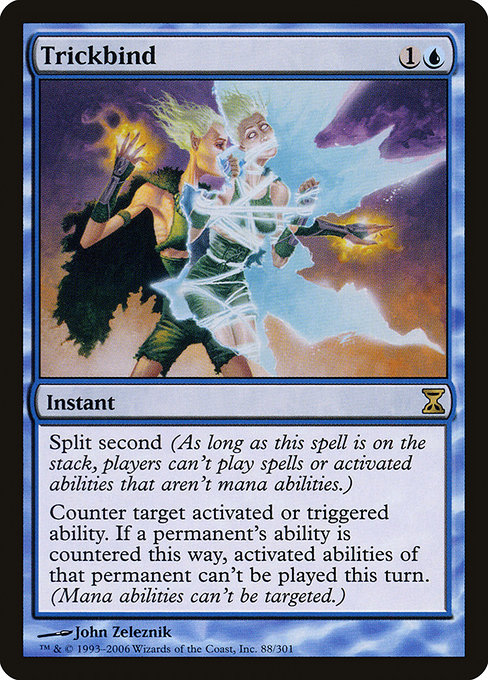
Image courtesy of Scryfall.com
Old vs New MTG Storytelling: What Trickbind Teaches Us
In the grand tapestry of Magic: The Gathering, storytelling has always walked a fine line between epic lore and intimate, card-by-card moments. The early days leaned heavily on sprawling mythologies and flavor text that invited players to imagine entire worlds beyond the battlefield. Today, storytelling stretches across sets, web articles, digital environments, and the way a single card feels in your hand. Trickbind, a Time Spiral rare from 2006, is a perfect lens for examining how older storytelling approaches and newer design philosophies intersect on the tabletop 🧙♂️🔥. Its text is compact, its art is telling, and its timing within the game mirrors a narrative pause that can change how a story unfolds in a single turn.
Trickbind is a blue instant with a modest mana cost of {1}{U}, a color identity that has long prided itself on tempo, control, and counterplay. The spell’s essence—Split second—sets the stage for a dramatic storytelling beat: as long as Trickbind sits on the stack, players can’t cast spells or activate abilities that aren’t mana abilities. In human terms, the moment is frozen. The narrative twist arrives when you counter a critical activated or triggered ability, freezing a key plan in its tracks. The flavor of “bind” evokes a clever trap and a pause in momentum, a staple of classic blue storytelling where thinking and timing matter more than brute force. This is not just card text; it’s a micro-story about control eclipsing chaos, a hallmark of the blue arc in the saga of MTG 🧙♂️🎨.
From a gameplay perspective, Trickbind embodies how older storytelling emphasized clever, cerebral plays. The ability to counter an activated or triggered ability can turn a potential comeback into a frozen tableau. If a permanent's ability is countered this way, all of that permanent’s activated abilities are shut down for the rest of the turn. It’s a high-leverage moment: one decision, one spell, and an entire plan can unravel with elegant restraint. The split-second window mirrors the dramatic pauses in classic storytelling—the hero finds a counterargument just as a villain unveils their ace. In modern MTG design, this sense of narrative timing has expanded into broader strategies—tempo, stax play, and interactive frameworks that keep audiences glued to the board and the lore 🧙♂️⚔️.
Flavor, art, and the design rhetoric of blue
The Time Spiral era itself is a love letter to MTG’s past and its evolving future. Trickbind carries that nostalgia while leaning into a design that rewards precise sequencing and planning. The card’s art, by John Zeleznik, captures a moment of subdued yet electric tension—the moment right before a cascade of blue mana and cunning triggers reshapes the battlefield. The blue color identity emphasizes intellect, patience, and the thrill of out-thinking an opponent, a theme that remains central to many contemporary storytelling threads. And the concept of split second—the original keyword that locks players into a single, decisive moment—serves as a storytelling device as well: it invites players to imagine what happens just after a choice is made and what could have happened if the twist had swung differently 🧙♂️💎.
Design-wise, Trickbind shows how word economy and mechanic clarity can convey a larger lore idea: restraint as power. In an age of expansive flavor texts and interconnected narratives across Universes Beyond and digital platforms, a single card can still communicate a slice of the world’s history. The Time Spiral set itself functioned as a bridge between eras, encouraging players to reflect on how past decisions shape present possibilities. That meta-narrative resonates with modern storytelling strategies, which often weave live storytelling with collectible artifacts, gameplay moments, and player-driven communities. It’s a reminder that good stories aren’t just about what’s written; they’re about what players do with what’s written 🧙♂️🎲.
From a collector’s perspective, Trickbind’s rarity and repute—rare in Time Spiral, with both foil and nonfoil printing—echo the way older stories become cherished through scarcity and nostalgia. The card’s historical footprint, price points, and EDH/Legacy relevance contribute to its status as a narrative artifact as well as a playable tool. In modern lore-building, that duality—story as object and story as action—continues to matter, whether you’re chasing art, flavor text, or the precise beats of a control-heavy game plan 🔥🎨.
As new sets push the boundaries of storytelling with dynamic arcs, cinematic storytelling, and cross-media tie-ins, Trickbind invites us to pause and consider how those methods shape our experience. The old-school thrill of a well-timed counterspell, the narrative texture of a single line of text, and the evocative art that embodies a moment in time all contribute to a cohesive, living story. In today’s MTG, where communities debate the implications of new mechanics and the cadence of storylines across blocks, Trickbind stands as a compact artifact of tempo, restraint, and the timeless appeal of blue’s storytelling toolkit 🧙♂️⚔️.
Meanwhile, if you’re stacking hours of strategy and savoring the tactile joy of a well-loved card, you might as well make your desk a little brighter and more personal. The Custom Neon Desk Mouse Pad from our partner shop adds a splash of glow to long gaming sessions without stealing the spotlight from your draw steps and combat phases. It’s a small, practical nod to the same spirit that Trickbind embodies: deliberate choice, a dash of flair, and a touch of neon magic to keep you company between turns.
Custom Neon Desk Mouse Pad 9.3x7.8 inMore from our network
- https://crypto-acolytes.xyz/blog/post/rediscovering-retro-educational-computer-titles-a-nostalgic-journey/
- https://blog.digital-vault.xyz/blog/post/mirror-wall-price-trends-secondary-market-insights-for-mtg-collectors/
- https://blog.digital-vault.xyz/blog/post/influence-of-fans-on-genasi-rabble-rouser-card-design/
- https://crypto-acolytes.xyz/blog/post/from-arcades-to-home-how-controllers-evolved/
- https://crypto-acolytes.xyz/blog/post/defi-oracles-and-secure-dex-trading-a-trust-framework/